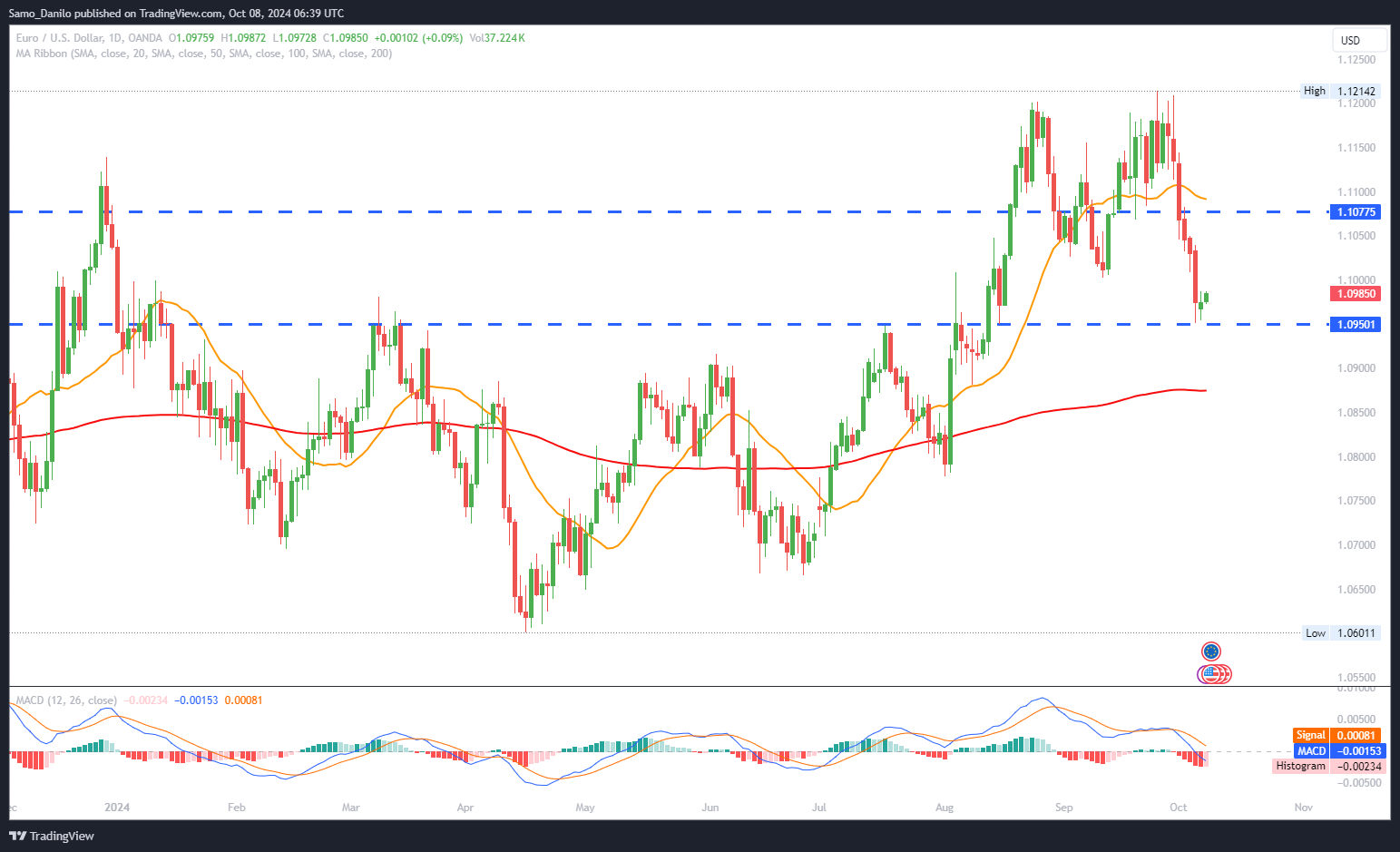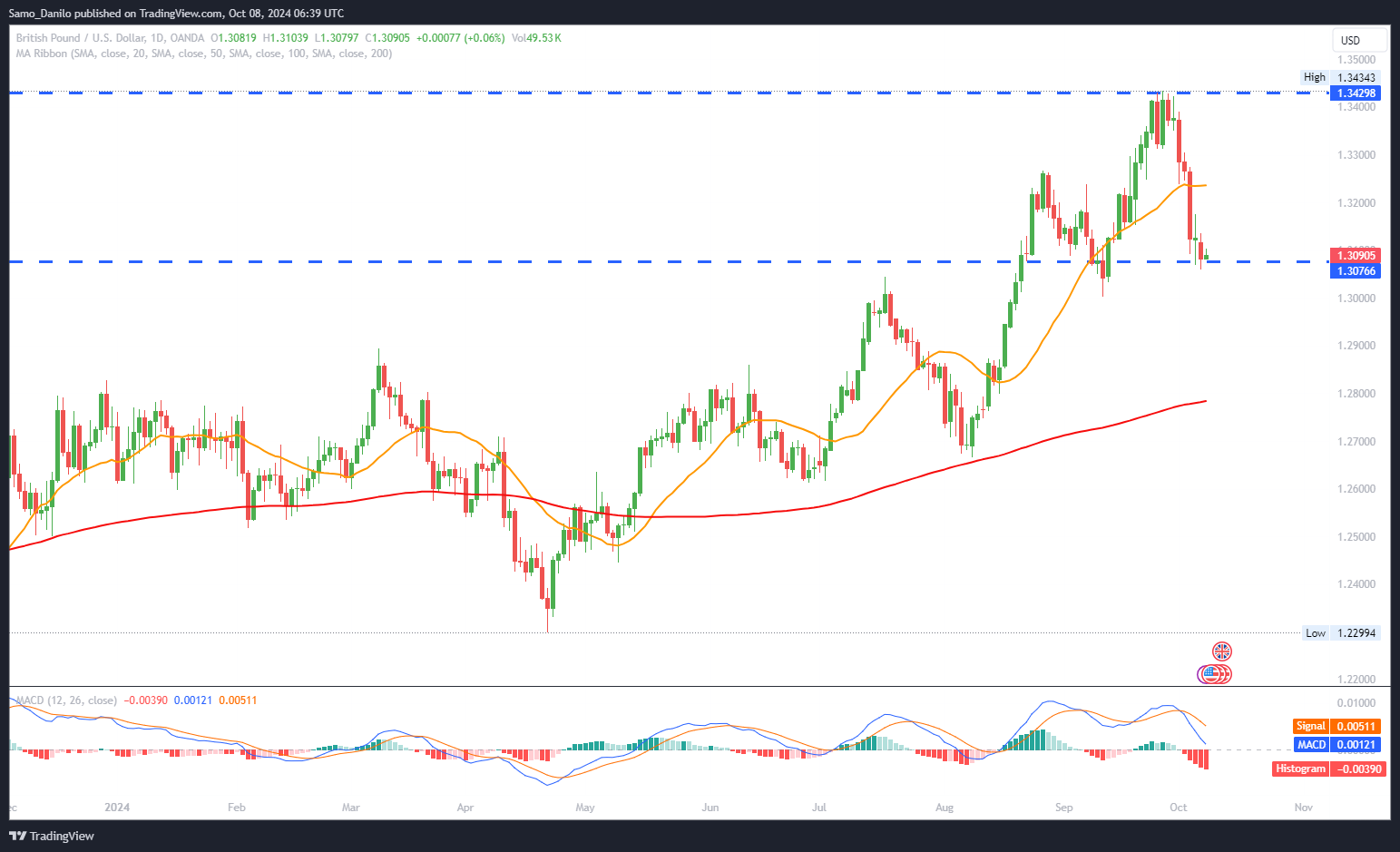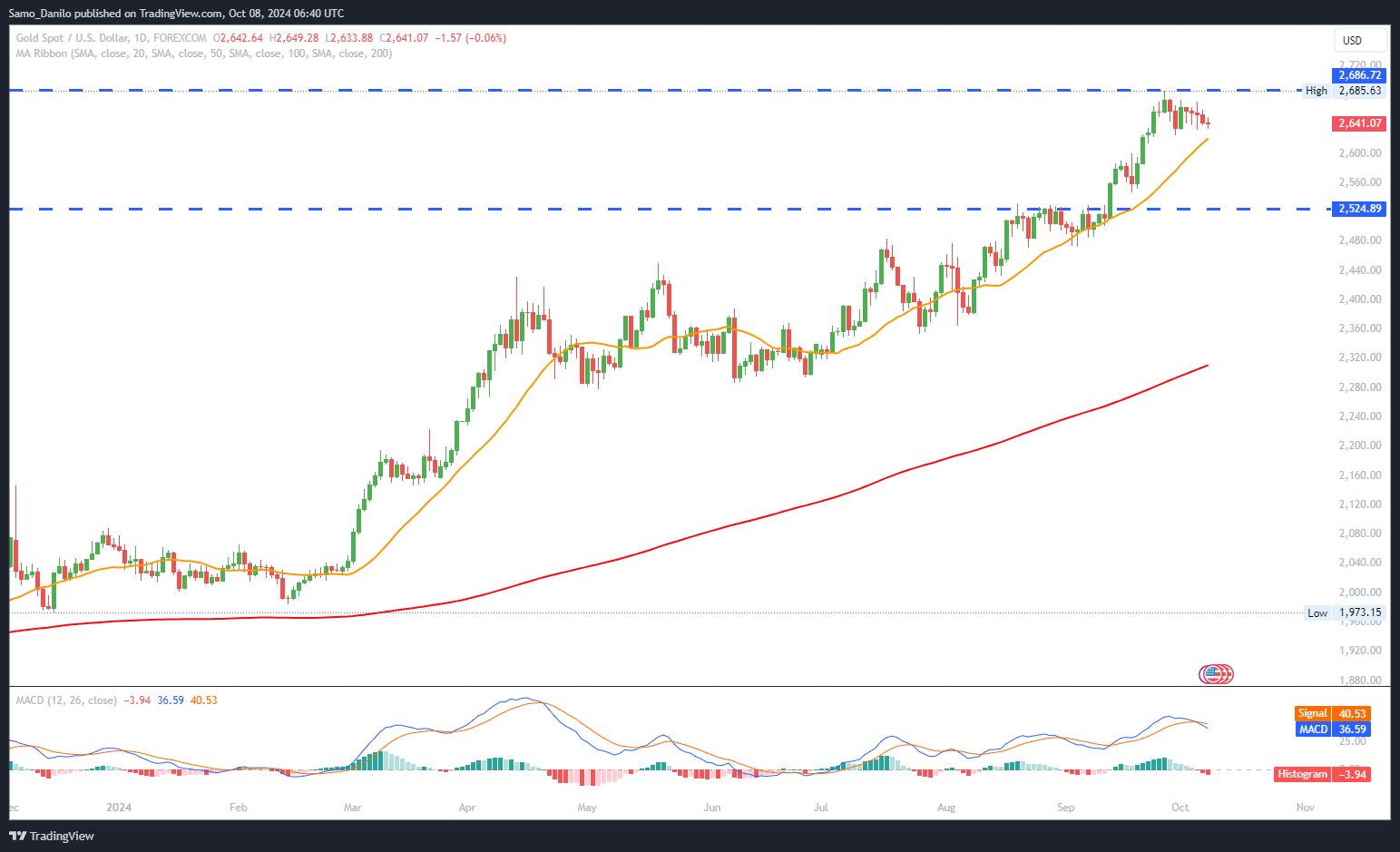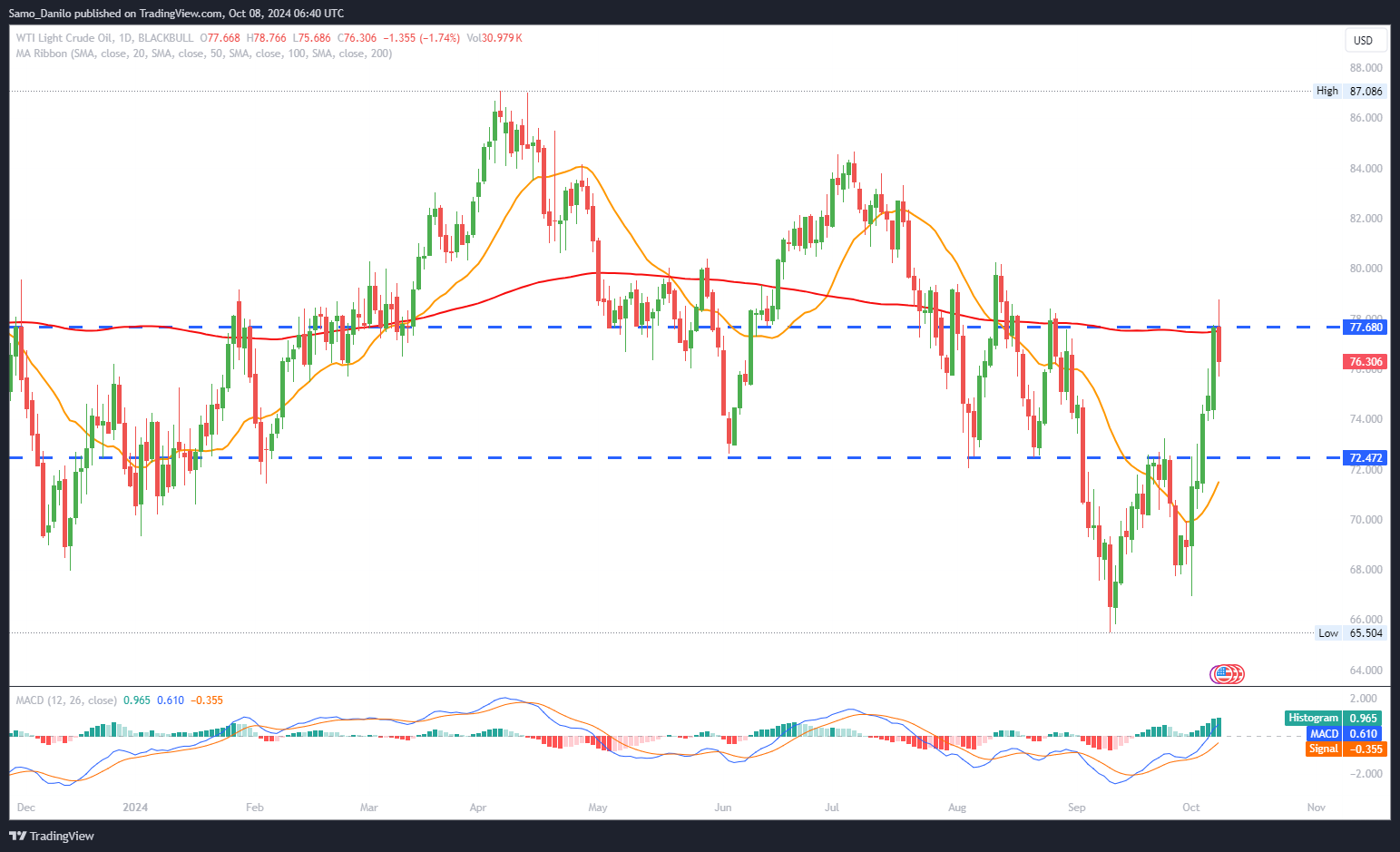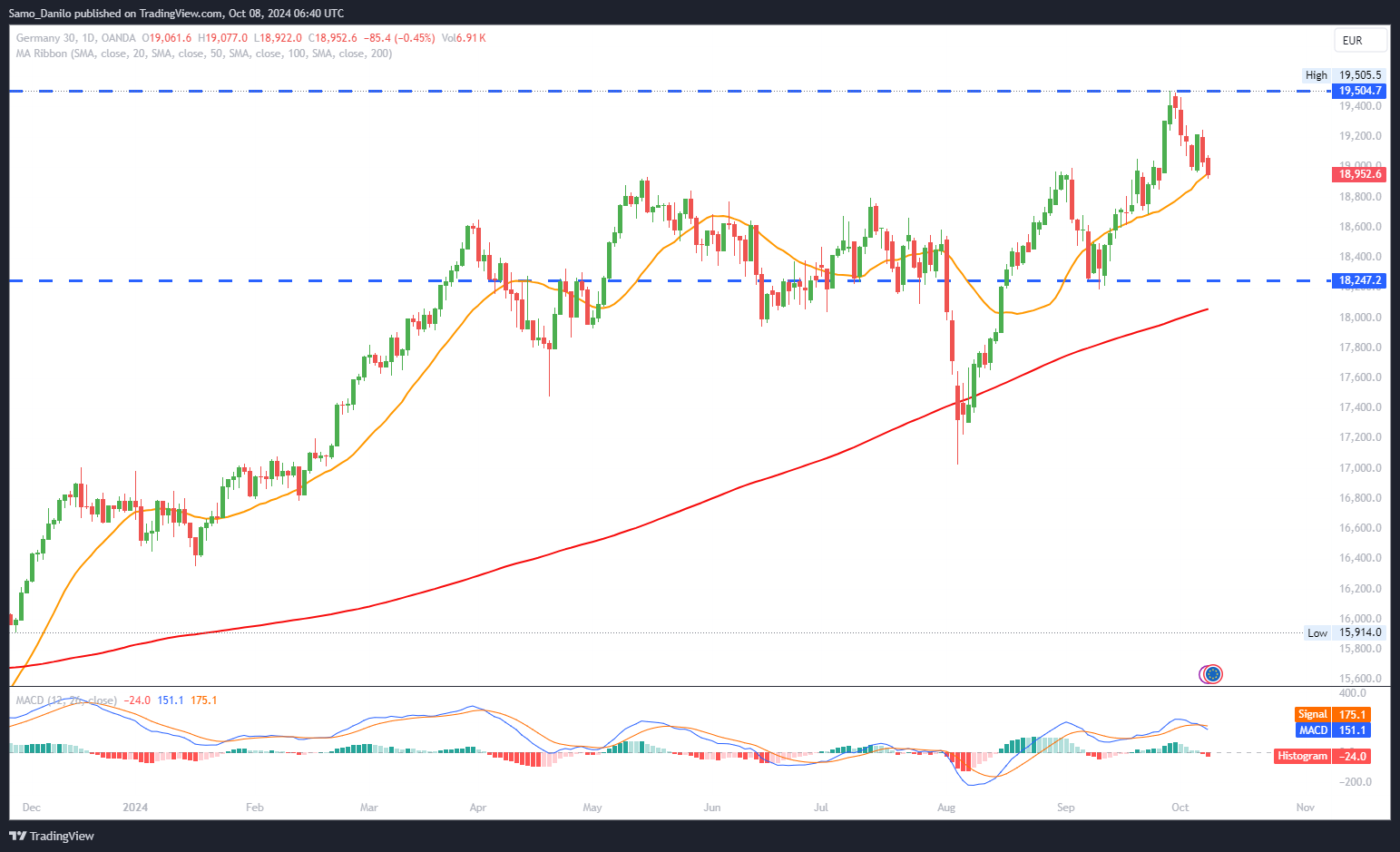EURUSD
- EUR/USD Recovery: The EUR/USD pair edged higher to around 1.0990 during early European trading on Tuesday, making its recovery from recent lows. The move reflects some stabilization as investors digest a mix of data points from the Eurozone that signal ongoing economic uncertainty.
- EU Data: The latest data showed the Sentix Investor Confidence Index for October improving to -13.8 from -15.4 in September, indicating a slight improvement in sentiment. Additionally, Eurozone Retail Sales for August rose by 0.2% month-over- month (MoM) and 0.8% year-over-year (YoY), suggesting some resilience in consumer demand, albeit still at subdued levels.
- German Factory Orders: Countering the positive retail data, German Factory Orders fell sharply by 5.8% in August compared to the previous month, marking a significant downturn in Europe's largest economy. On an annual basis, orders were down by 3.9%, adding to fears of a prolonged manufacturing recession in Germany, which could spill over to the broader Eurozone.
- ECB’s Statement: In a Tuesday interview, ECB Vice-Chair of the Supervisory Board Frank Elderson noted that economic growth risks are materializing, highlighting the fragile state of the Eurozone economy. He reiterated that the ECB’s decisions are made on a “meeting-by-meeting basis,” implying caution regarding future rate cuts. This aligns with the ECB’s recent shift to a more data-dependent stance amid easing inflation and a weakening economy.
- ECB’s Schnabel to Speak: ECB policymaker Isabel Schnabel is set to speak later in the day. Market participants will closely monitor her comments for any dovish hints or acknowledgement of the deteriorating economic outlook. A soft tone or additional concerns about growth could pressure the Euro lower against the USD, limiting the pair’s recovery.
Closing statement: The EUR/USD remains cautiously higher around 1.0990, benefiting from improved Eurozone sentiment data, but the fragile German economic situation and dovish signals from ECB policymakers could cap gains. A clear break above 1.1050 is needed to signal further upside, while any dovish ECB commentary or negative surprises in upcoming data could push the pair back toward 1.0950 or lower. Investors will continue to focus on central bank rhetoric and key macro data to gauge the next directional move for the pair.
GBPUSD
- GBP/USD Gains: The GBP/USD pair sees a modest rebound on Tuesday, snapping a five-day losing streak that pushed it to a multi-week low. This positive traction comes as traders show renewed interest in the Pound Sterling, helping the pair recover from its recent downside despite ongoing geopolitical and economic uncertainties.
- US Dollar Depressed: The US Dollar (USD) remains on the back foot, trading below a seven-week high reached last Friday. This weaker USD tone serves as a key factor supporting the GBP/USD pair, offering some breathing space for the Pound. The USD weakness is primarily driven by a slight pullback in US Treasury yields and cautious sentiment surrounding the Federal Reserve’s policy outlook.
- Middle East Conflict: Investors continue to closely monitor the geopolitical situation in the Middle East, as escalating tensions raise concerns about a broader regional conflict. The lingering risk aversion and uncertainty limit the potential upside for the GBP/USD pair, as safe-haven demand still provides some support for the USD.
- BoE’s Bailey Hints: Last week, Bank of England (BoE) Governor Andrew Bailey indicated that the central bank might adopt a more aggressive stance on cutting interest rates if inflation data shows further signs of improvement. This dovish rhetoric has weighed on the Pound in recent sessions, with markets now speculating on the timing and magnitude of future rate cuts amid a slowing UK economy.
- Lack of Major Economic Data: There are no significant economic releases from either the UK or the US scheduled for Tuesday, leaving the GBP/USD pair to be influenced mainly by Federal Reserve commentary (Fedspeak) and broader market sentiment. Traders will watch for any shifts in Fed officials' tone that could impact the USD, and by extension, the GBP/USD pair.
| SMA (20) | Rising |
|
|
| RSI (14) | Falling |
|
|
| MACD (12, 26, 9) | Falling |
|
|
Closing statement: The GBP/USD is showing some resilience after a prolonged downtrend, but a sustained move above the 1.3150-1.3200 resistance zone is required to confirm a near-term bottom. With no major data on the calendar, the pair’s movement will hinge on broader risk sentiment and comments from US and UK central bank officials. A continued USD pullback could support further gains, while any signs of heightened Middle East tensions may limit the pair’s upside potential.
GOLD
- Gold Price: The XAU/USD pair extends its corrective decline early on Tuesday, trading close to the lower boundary of its recent range at around $2,630. The yellow metal remains on the back foot amid a cautious risk sentiment across global markets, leaving traders uncertain about the near-term direction.
- China’s Economic Outlook: Despite Chinese stocks reopening strongly after the Golden Week holiday, the absence of new stimulus announcements weighed on sentiment. Furthermore, the National Development and Reform Commission (NDRC) delivered a downbeat economic outlook, exacerbating risk aversion in Asia and adding downward pressure on gold prices as investors shy away from non-yielding assets.
- Dovish Fed Commentary: Gold found some support from recent dovish remarks by St. Louis Fed President Alberto Musalem. He indicated that "further gradual reductions in the policy rate will likely be appropriate over time," adding caution to the Fed’s outlook. These comments have tempered US Dollar strength, providing some relief to gold, which is priced in USD.
- Rate Cut Possibility: According to the CME Group's FedWatch Tool, markets are currently assigning an 86% probability of a 25-basis point (bps) rate cut by the Federal Reserve at its next policy meeting. This high expectation of easing monetary policy has lent some underlying support to gold, as lower rates reduce the opportunity cost of holding the non-yielding precious metal.
- Fedspeak: With no major economic data releases on Tuesday, market participants will focus on speeches from Atlanta Fed President Raphael Bostic and Fed Vice Chairman Philip Jefferson. Any unexpected comments from these officials could provide fresh impetus for gold price action, especially if they hint at a possible shift in the Fed’s monetary policy trajectory.
| SMA (20) | Rising |
|
|
| RSI (14) | Rising |
|
|
| MACD (12, 26, 9) | Rising |
|
|
Closing statement: Gold remains vulnerable to a further downside break if the lower boundary around $2,630 fails to hold. With mixed signals from the Fed and a lack of fresh stimulus from China, traders are likely to remain cautious. A dovish tone from upcoming Fed speakers could support a rebound, but renewed risk aversion or stronger USD momentum may cap gains in the near term. Traders should monitor geopolitical developments and Fed commentary closely for directional cues.
CRUDE OIL
- WTI Price: West Texas Intermediate (WTI), the US crude oil benchmark, is trading around $75.90 on Thursday. The recent rally in oil prices has been largely fueled by growing fears that Israel may be preparing to target Iran’s oil infrastructure in retaliation for Tehran’s ballistic missile attack earlier this week.
- Geopolitical Tensions: The escalating conflict in the Middle East has overshadowed other market dynamics, keeping traders on edge. Concerns about potential disruptions to global oil supply have propelled prices higher, as any action targeting Iran’s oil industry could significantly impact output, tightening an already sensitive oil market.
- Sluggish Chinese Demand: While geopolitical tensions are lifting prices in the short term, sluggish demand from China — the world’s largest oil importer — and a gloomy global economic outlook have dampened the medium-to-long-term sentiment. A slower-than-expected recovery in Chinese industrial activity has contributed to an uncertain demand picture, capping further gains in crude oil prices.
- Kazakhstan’s Oil Production: Adding to supply concerns, the Kazakhstan Ministry of Energy confirmed that oil production at the major Kashagan Oil and Gas field has been suspended due to a scheduled overhaul. The shutdown is expected to be a key driver of short-term price fluctuations, as any delay in restarting production could further tighten supply in the region.
- Libyan Oil Exports: On a more positive note, Libya’s oil exports are reportedly soaring past the 1 million barrels per day mark following the resolution of a political impasse. This increase in output may help offset some of the supply risks emanating from the Middle East, although it remains to be seen how sustainable this surge will be, given Libya’s history of production disruptions.
| SMA (20) | Falling |
|
|
| RSI (14) | Rising |
|
|
| MACD (12, 26, 9) | Rising |
|
|
Closing statement: WTI crude remains highly sensitive to geopolitical headlines, with escalating tensions in the Middle East likely to dominate the near-term outlook. While suspended output in Kazakhstan and slower Chinese demand cloud the picture, a rebound in Libyan exports could provide some counterbalance. Traders should stay alert for any updates on the Israel-Iran conflict, as these could trigger sharp price movements. If stability returns to the region, oil may face renewed downward pressure, particularly if sluggish global demand persists.
DAX
- Auto Stocks: DAX auto stocks extended gains from Friday, buoyed by optimism around potential EU tariffs on China’s electric vehicles (EV). Mercedes-Benz Group and Porsche advanced by 0.61% and 0.55%, respectively, as investors speculated that such measures could reduce competition for European automakers and boost domestic sales.
- German Factory Orders: German factory orders declined sharply in August, dropping by 5.8% month-over-month. The downturn was led by a steep 10.9% decline in domestic orders, reinforcing fears of an economic contraction in Germany for 2024. The data has heightened concerns about the outlook for Europe’s largest economy, which remains weighed down by persistent inflationary pressures and weakening global demand.
- Mixed Manufacturing Output: Despite the slump in factory orders, real (price-adjusted) manufacturing production in Germany showed a surprising 2.9% increase in August compared to the previous month, according to preliminary data from the Federal Statistical Office (Destatis). While the uptick offers a glimmer of hope, analysts caution that it may be temporary, given the broader economic challenges.
- Economic Ministry Prediction: Germany’s economic ministry projected on Monday that the German economy would contract by 0.2% in 2024, citing weak domestic consumption, subdued business investment, and a slowdown in exports. The downbeat outlook follows recent PMI surveys that pointed to a sharp decline in new orders, raising the risk of a prolonged downturn for Germany’s manufacturing sector.
- US Data: In the US, the RCM/TIPP Economic Optimism Index will be in focus later today. The index, which provides insights into consumer sentiment and economic expectations, is projected to rise from 46.1 in September to 47.2 in October. A stronger-than-expected reading could reduce the likelihood of aggressive Fed rate cuts, impacting broader risk sentiment and, in turn, influencing demand for DAX-listed stocks.
| SMA (20) | Rising |
|
|
| RSI (14) | Slightly Falling |
| |
| MACD (12, 26, 9) | Rising |
|
|
Closing statement: The DAX remains under pressure from a deteriorating economic outlook in Germany, despite recent gains in the auto sector. Any further signs of weakness in Germany’s industrial sector could weigh on the index, particularly as recession fears intensify. Meanwhile, US economic sentiment data will likely set the tone for broader market movements, with implications for the Fed’s policy path and global risk appetite.
